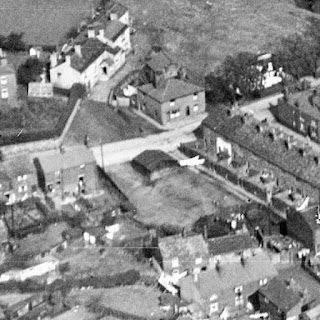Junction Road tails off the right and the Kings Head is on the let on this 2012 shot (copyright Google Street View). Two properties stood where the area of trees is in the centre of the image and it is believed the New Brook House Inn was one of those properties.
Like the rest of
Bolton, the Deane area has suffered from pub closures in recent years. Two of
the five pubs in the ‘village’ itself – the Church and the Stag’s Head – have both closed, but there are a couple of long lost pubs worth giving a
mention to. The New Brook House
Inn, was one of them. Long lost, indeed, as it appears on
very few historical records.
The New Brook is
numbered 52, Junction Road on old directories.
The Kings Head is today numbered 52-54 Junction Road. However, we
believe the New Brook is likely to have been one of two now-demolished properties
on the front of Junction Road just before the entrance to the Kings Head. Certainly, the 1911 Census enumerator surveyed Sunny Bank, the New Brook Inn and the Kings Head, in that order. Any
information that proves us right or wrong on that would be gratefully received.
The first definitive
record we have of the New Brook Inn is with Betsy Pasquill running a shop and
beerhouse on Junction Road according to the Worralls Directory of 1871. That
suggests the pub dates back to at least the late-1860s.
In 1891, the vicar of Deane
church, the Reverend HS Patterson proposed the establishment of the Deane
Village Club, a temperance and educational institution. The club was to incorporate a café, a gymnasium, meeting rooms and a bowling green and in a
pamphlet detailing his plans, the Reverend Patterson gave notice of where he
saw the club’s custom coming from:
“This building will be
situated on Junction road, opposite the Church, which is a street of 300 yards
and has the following public-houses:- The Vulcan, Queen Anne, New Brook Inn,
and King's Head. Here the forces are against thrift and social progress.” [1]
But the Reverend
Patterson’s grand plans didn’t quite come to fruition on the scale he intended
and in the end only a small corrugated building was constructed. Of the four pubs in the
good reverend’s sights, the New Brook was to continue for another
quarter-century or so, the rest a good deal longer with three still in
existence.
Another member of the
Pasquill family, Robert Pasquill, was running the New Brook by the early-1890s.
Prior to taking over the pub he was living in Fernhill Gate and working as a
coal miner, presumably at the Victoria Pit where the garden centre now stands.
Robert’s tenure didn’t
last long and by 1894 the beerhouse was in the hands of the Workman family who
ran it for the rest of its time that it was open to the public.
Landlord Thomas Workman
was hauled before the magistrates in 1895 on a charge of having
permitted betting at the pub. Then, as now, gambling in pubs was illegal, but
the charge was of an extremely petty nature. Plain-clothes policemen entered
the pub on 15 November 1895. There were nine men in the tap room, four of whom were sitting round a table playing dominoes. The
officers watched the four men play three games. At the conclusion
of each game the losers paid for half-pints of beer for the winners. Despite a
string of witnesses testifying that no gambling for booze took place the
magistrates found Mr Workman guilty of allowing gambling on his premises. He
was fined £2 with one guinea (£1.05) as an advocate’s fee - £3.05 in total or the
equivalent of over £330 today. [2]
Fortunately, Mr Workman didn’t have his licence endorsed which may have affected his chances of renewal at the annual Brewster sessions.
The officers went straight from the New Brook to the nearby Church Inn
on Wigan Road where they found ten men playing dominoes for cash stakes of two
old pence (or 1p) per corner. The licensee, William Gaskell, was fined £5 plus a
one guinea advocate’s fee.
The New Brook continued as a pub until 1915. A few years before, in 1906, Deane Golf Club was
formed. But in May 1915 their clubhouse was destroyed by fire. They were
offered the New Brook Inn as alternative premises and occupied the former pub
until their new club house was completed in 1920. [3] They continued to use the New Brook for some years after. It was probably demolished in the 1940s.
An aerial shot - date unknown - of the Kings Head in the top left of the photo with the building that was formerly the Newbrook Inn in front of it.
[2]
Manchester Courier, 30 November 1895.












